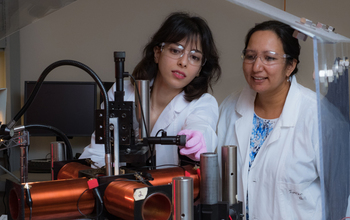Multimedia Gallery
Fast-spinning spheres show nanoscale systems’ secrets (Image 3)
Rice University graduate student Elaa Hilou (left) and Professor Sibani Lisa Biswal prepare an experiment in a device that combines a rotating magnetic field and a microscope. The researchers are studying the effects of a spinning field on magnetic particles. Their findings could help researchers model colloids for cosmetics as well as catalysts for chemicals, among other applications, in a physical system. [Image 3 of 3 related images. Back to Image 1.]
More about this image
Experiments in the lab of Rice University chemical engineer Sibani Lisa Biswal show micron-sized spheres coming together under the influence of a rapidly spinning magnetic field. That’s no surprise because the particles themselves are magnetized. But how they come together is of interest, as the particles first gather into a disorganized aggregated cluster and then into a crystal-like regimen as the magnetic field becomes stronger.
Biswal and graduate student Elaa Hilou, who worked on the research together, hope it will inspire ways to look at, model and create novel 2D materials like tunable catalysts or colloids that can change their surface area on demand.
Findings from the research could also help researchers model colloids for cosmetics as well as catalysts for chemicals, among other applications, in a physical system.
The research was supported in part by the National Science Foundation (NSF) (grant CBET 17-055703, and through support of an NSF Graduate Research Fellowship, DGE 14-50681).
To learn more, see the NSF News From the Field story Fast-spinning spheres show nanoscale systems’ secrets. (Date image taken: unknown; date originally posted to NSF Multimedia Gallery: Dec. 11, 2018)
Credit: Jeff Fitlow/Rice University
Images and other media in the National Science Foundation Multimedia Gallery are available for use in print and electronic material by NSF employees, members of the media, university staff, teachers and the general public. All media in the gallery are intended for personal, educational and nonprofit/non-commercial use only.
Images credited to the National Science Foundation, a federal agency, are in the public domain. The images were created by employees of the United States Government as part of their official duties or prepared by contractors as "works for hire" for NSF. You may freely use NSF-credited images and, at your discretion, credit NSF with a "Courtesy: National Science Foundation" notation.
Additional information about general usage can be found in Conditions.
Also Available:
Download the high-resolution JPG version of the image. (7.1 MB)
Use your mouse to right-click (Mac users may need to Ctrl-click) the link above and choose the option that will save the file or target to your computer.

